- The universe is made up mostly of dark energy and dark matter, physicists believe
- Humans cannot detect dark matter; it is invisible
- A device in space may have found hints of it in anti-matter particles
- These could come from other sources but look consistent with dark matter
(CNN) -- Take a look around you, and in your mind's eye, randomly wipe out all but a small fraction of what you can see. Pretend the vast rest of reality is there but invisible.
You'd probably like a device that helps you see much more of it.
Scientists working at CERN, the European Organization for Nuclear Research, have made some progress in that direction with the Alpha Magnetic Spectrometer (AMS), which has been riding aboard the International Space Station since 2011.
Physicists believe that mental exercise in blindness reflects the reality of our universe, only about 4% of which manifests as the kind of matter and energy we can perceive.
More than 70% consists of so-called dark energy, physicists say, and more than 20% is dark matter, neither of which humans can directly detect so far.
But scientists feel certain it must exist, partly because of the gravity it exerts on the visible universe.
 CERN's Alpha Magnetic Spectrometer rides atop the International Space Station to detect signs of mysterious dark matter.
CERN's Alpha Magnetic Spectrometer rides atop the International Space Station to detect signs of mysterious dark matter.  The AMS was delivered to the International Space Station in May 2011 by the Space Shuttle Endeavour.
The AMS was delivered to the International Space Station in May 2011 by the Space Shuttle Endeavour.  Scientists at CERN's AMS control center in France monitor the path of the ISS and adjust the spectrometer experiment to changing space conditions.
Scientists at CERN's AMS control center in France monitor the path of the ISS and adjust the spectrometer experiment to changing space conditions. Device on the ISS searches for dark matter
Device on the ISS searches for dark matter
Device on the ISS searches for dark matter

 The Large Hadron Collider is located at CERN, the European Organization for Nuclear Research, near Geneva, Switzerland. This is CERN's Globe of Science and Innovation, which hosts a small museum about particle physics inside. The ATLAS experiment is housed underground nearby.
The Large Hadron Collider is located at CERN, the European Organization for Nuclear Research, near Geneva, Switzerland. This is CERN's Globe of Science and Innovation, which hosts a small museum about particle physics inside. The ATLAS experiment is housed underground nearby.  The Higgs boson, the elusive particle that scientists had hoped to find for decades, was detected by two general-purpose experiments at the Large Hadron Collider, as scientists announced in 2012. The Compact Muon Solenoid (CMS) experiment, pictured, is one of them.
The Higgs boson, the elusive particle that scientists had hoped to find for decades, was detected by two general-purpose experiments at the Large Hadron Collider, as scientists announced in 2012. The Compact Muon Solenoid (CMS) experiment, pictured, is one of them.  The ATLAS experiment, seen here in 2011, also detected the Higgs boson, a particle that helps explain why matter has mass. It has been called the "God particle" because of a book by that title, but scientists hate the name.
The ATLAS experiment, seen here in 2011, also detected the Higgs boson, a particle that helps explain why matter has mass. It has been called the "God particle" because of a book by that title, but scientists hate the name.  Much of three stories of electronics at CMS are involved in making split-second decisions about what data to keep and what to discard. This is one of those areas.
Much of three stories of electronics at CMS are involved in making split-second decisions about what data to keep and what to discard. This is one of those areas.  A technician works on the CMS experiment. Technicians are adding new cooling lines for CMS for a system that will be put in place in two or three years.
A technician works on the CMS experiment. Technicians are adding new cooling lines for CMS for a system that will be put in place in two or three years. 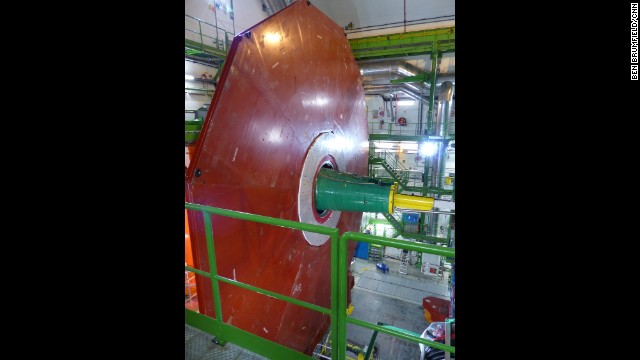 CMS is adding this layer for the next run of particle collisions to improve the detection of muons, which are fundamental particles.
CMS is adding this layer for the next run of particle collisions to improve the detection of muons, which are fundamental particles.  Joe Incandela, the spokesperson for CMS, says that about 4,000 scientists work there.
Joe Incandela, the spokesperson for CMS, says that about 4,000 scientists work there.  Physicists in the CMS control room. Although the particle accelerator is shut down until 2015, this is a busy time for everyone involved in upgrading the particle detectors and analyzing data from the first run of particle collisions.
Physicists in the CMS control room. Although the particle accelerator is shut down until 2015, this is a busy time for everyone involved in upgrading the particle detectors and analyzing data from the first run of particle collisions.  The nearly 14,000 tons of machinery can all collapse together, or separate, when high-pressure air is pumped in. This is one of the pads to help slide it all around.
The nearly 14,000 tons of machinery can all collapse together, or separate, when high-pressure air is pumped in. This is one of the pads to help slide it all around. 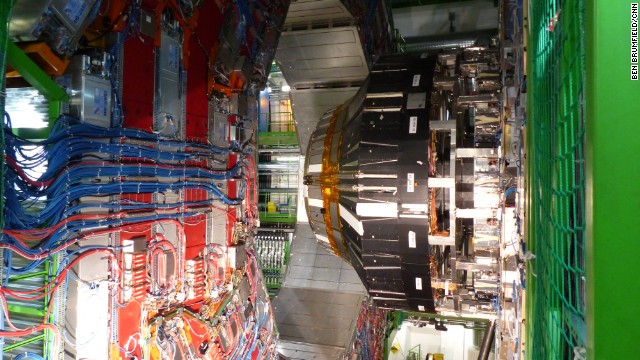 CMS has 76,000 lead-tungstate crystals that shatter electrons and photons, allowing scientists to observe particles such as the Higgs boson that exist for only an instant. Some of those crystals are in the endcap.
CMS has 76,000 lead-tungstate crystals that shatter electrons and photons, allowing scientists to observe particles such as the Higgs boson that exist for only an instant. Some of those crystals are in the endcap. 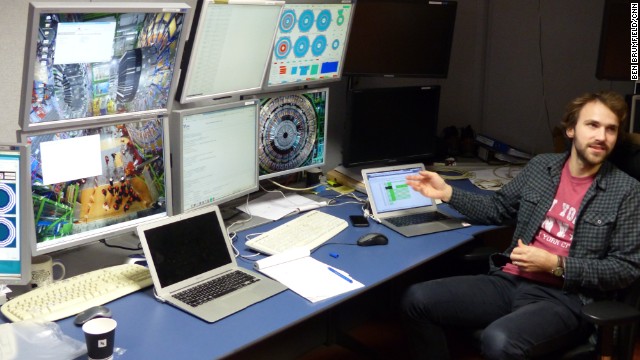 Evaldas Juska, an engineer, is working on computers involved with CMS.
Evaldas Juska, an engineer, is working on computers involved with CMS.  CMS was constructed at ground level, then pieces of it were lowered through this hole in the cavern.
CMS was constructed at ground level, then pieces of it were lowered through this hole in the cavern.  This is the CERN Computing Center. Tim Berners-Lee invented the World Wide Web at CERN.
This is the CERN Computing Center. Tim Berners-Lee invented the World Wide Web at CERN. 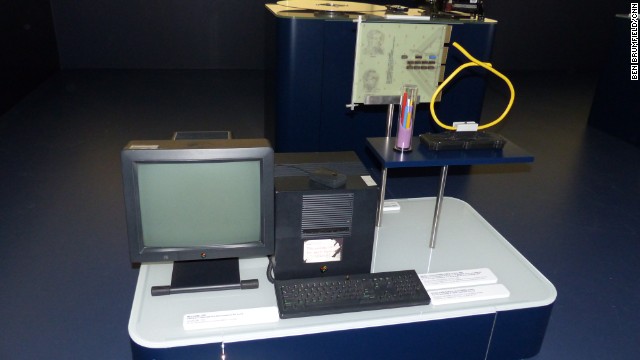 One of the world's first web servers, a NeXT computer from 1991, is seen at CERN. The handwritten note indicates, "This machine is a server. DO NOT POWER DOWN!" On the right is an old Ethernet cable, which can handle only 10 Mb/second, and was largely replaced by the mid-'90s.
One of the world's first web servers, a NeXT computer from 1991, is seen at CERN. The handwritten note indicates, "This machine is a server. DO NOT POWER DOWN!" On the right is an old Ethernet cable, which can handle only 10 Mb/second, and was largely replaced by the mid-'90s.  While they take their work seriously, that doesn't mean the scientists at CERN don't have a sense of humor. Here we see CERN's "Animal Shelter for Computer Mice," where used and unwanted computer mice have a place to call home.
While they take their work seriously, that doesn't mean the scientists at CERN don't have a sense of humor. Here we see CERN's "Animal Shelter for Computer Mice," where used and unwanted computer mice have a place to call home.  A sculpture garden featuring artwork made from pieces of old experiments decorates the grounds at CERN.
A sculpture garden featuring artwork made from pieces of old experiments decorates the grounds at CERN.  A collection of empty relics from the celebrations of different milestones of the CMS experiment.
A collection of empty relics from the celebrations of different milestones of the CMS experiment. 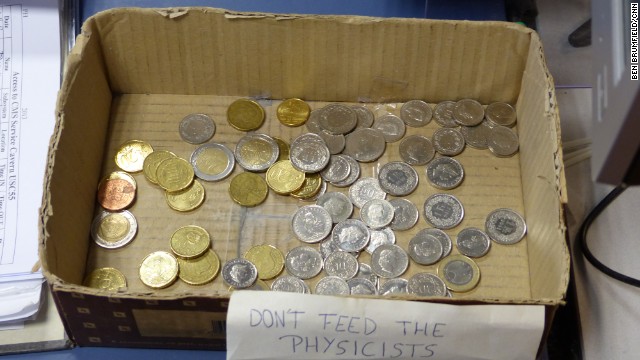 "Don't feed the physicists" marks a box of coins where CMS scientists deposit change to pay for coffee.
"Don't feed the physicists" marks a box of coins where CMS scientists deposit change to pay for coffee. Exploring the universe at CERN
Exploring the universe at CERN
Exploring the universe at CERN
Exploring the universe at CERN
Exploring the universe at CERN
Exploring the universe at CERN
Exploring the universe at CERN
Exploring the universe at CERN
Exploring the universe at CERN
Exploring the universe at CERN
Exploring the universe at CERN
Exploring the universe at CERN
Exploring the universe at CERN
Exploring the universe at CERN
Exploring the universe at CERN
Exploring the universe at CERN
Exploring the universe at CERN
Exploring the universe at CERN

This week, CERN scientists published an analysis of data from the AMS, which detects subatomic particles constantly bombarding Earth. They include exceedingly rare antimatter particles that can result from the breakdown of dark matter.
When dark matter collides
They are called positrons, also known as anti-electrons. They have the same mass as electrons, but electrons have a negative charge, and positrons have a positive charge.
Scientists believe dark matter collides, splitting into pairs of electrons and positrons, so the ability to examine positrons in detail could help in proving the existence of dark matter.
Positrons are produced in minute quantities in our corner of the universe, and mostly come flying our way from its far reaches, bundled up with gangs of other subatomic particles, mainly protons and electrons.
The flying particles bear the name "cosmic rays," a misnomer given to them at a time when they were not as well understood.
The AMS project has analyzed 41 billion cosmic ray particles, and determined 10 million of them to be made of electrons and positrons.

 Science on the big scale and the small scale is important for understanding the structure of the universe. The Hubble Space Telescope is looking for indications of dark matter in star clusters, while particle experiments are also hunting down this mysterious substance.
Science on the big scale and the small scale is important for understanding the structure of the universe. The Hubble Space Telescope is looking for indications of dark matter in star clusters, while particle experiments are also hunting down this mysterious substance. 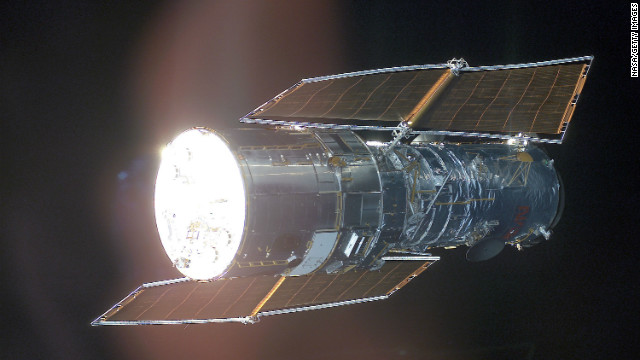 This is what the Hubble Space Telescope looks like.
This is what the Hubble Space Telescope looks like. 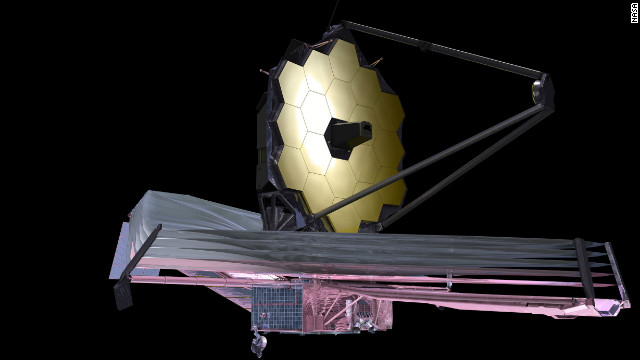 The James Webb Space Telescope, shown in this artist's depiction, would be even more powerful than the Hubble Space Telescope, and may enhance our understanding of enigmatic substances called dark matter and dark energy.
The James Webb Space Telescope, shown in this artist's depiction, would be even more powerful than the Hubble Space Telescope, and may enhance our understanding of enigmatic substances called dark matter and dark energy.  This graphic shows the evolution of the universe, combining the expansion history from supernova measurements with findings from NASA's WMAP satellite, launched in 2001. Dark energy is thought to be responsible for the acceleration of the universe's expansion.
This graphic shows the evolution of the universe, combining the expansion history from supernova measurements with findings from NASA's WMAP satellite, launched in 2001. Dark energy is thought to be responsible for the acceleration of the universe's expansion.  At the Large Hadron Collider at CERN, scientists smash particles into each other hoping to draw other, as-yet-unseen particles into existence, and could also find evidence of dark matter. The LHC is officially shut down for about two years while it receives maintenance and upgrades.
At the Large Hadron Collider at CERN, scientists smash particles into each other hoping to draw other, as-yet-unseen particles into existence, and could also find evidence of dark matter. The LHC is officially shut down for about two years while it receives maintenance and upgrades.  Michael Faraday used the principles of electricity to develop the electric motor, showing that pure science leads to technological innovations, in the 1800s.
Michael Faraday used the principles of electricity to develop the electric motor, showing that pure science leads to technological innovations, in the 1800s. 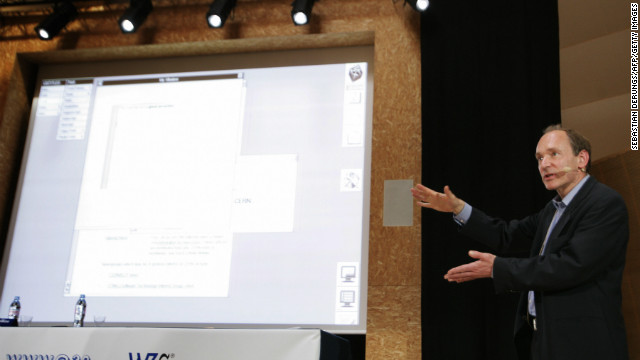 The World Wide Web was an unexpected invention that arose at CERN, to help physicists communicate better. Here, Tim Berners-Lee, who came up with it, demonstrates the NeXT computer on which he developed the Web.
The World Wide Web was an unexpected invention that arose at CERN, to help physicists communicate better. Here, Tim Berners-Lee, who came up with it, demonstrates the NeXT computer on which he developed the Web. 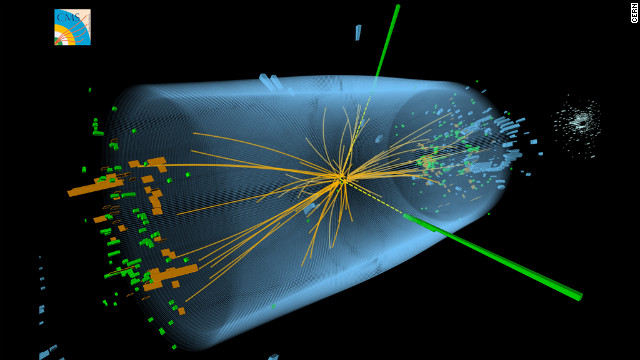 Scientists at the Large Hadron Collider detected a particle resembling the theorized Higgs boson, and announced this breakthrough in 2012. We may learn of amazing practical applications of the particle physics that goes on at the LHC, but no one knows what those will be.
Scientists at the Large Hadron Collider detected a particle resembling the theorized Higgs boson, and announced this breakthrough in 2012. We may learn of amazing practical applications of the particle physics that goes on at the LHC, but no one knows what those will be. 
Unprecedented data plus hope
There have been fluctuations in the number of positrons in the mix, and thanks to the orbiting spectrometer, for the first time in a half-century of cosmic ray research scientists have been able to measure an important peak in positrons.
"AMS now unveiled data that no other experiment could ever record," said CERN spokesman Arnaud Marsollier.
The data hint at the existence of dark matter. But CERN scientists are not completely sure yet that dark matter is the true source of the positrons.
"It may come from high-energy phenomena somewhere in our universe: But what?" Marsollier asks. "Pulsars? Supernovas?"
Pulsars are stars similar to black holes that spray particles and light through the universe. Supernovas are exploded former stars.
Because it detects particles as opposed to light, the way a telescope would, AMS may also be able to see other cosmic phenomena a telescope cannot.
The data released this week need more study, but at first glance, CERN says, what they have seen so far looks "tantalizingly consistent with dark matter particles."
If that's the case, the AMS may have begun to remove humanity's greatest blindfold.
No comments:
Post a Comment